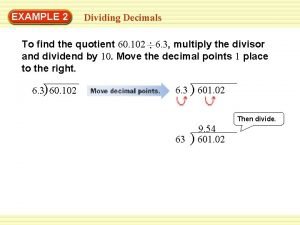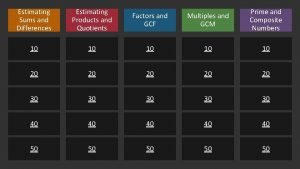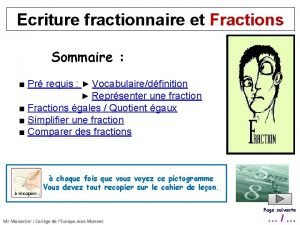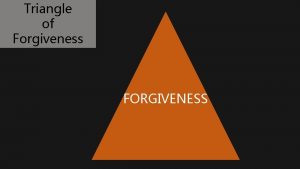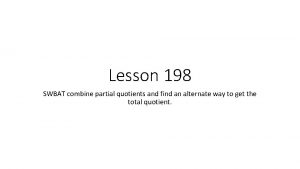The Forgiveness Method Partial Quotients Division The Partial










![Ask - How many [8 s] are in 17? There at least 2, so Ask - How many [8 s] are in 17? There at least 2, so](https://slidetodoc.com/presentation_image_h2/6b76e9bb6c8023accb2eb90daaa14ad3/image-11.jpg)














- Slides: 25

The Forgiveness Method & Partial Quotients Division • The Partial Quotients Algorithm uses a series of “at least, but less than” estimates of how many b’s in a. Students might begin with multiples of 10 – they’re easiest. This method builds towards traditional long division. It removes difficulties and errors associated with simple structure mistakes of long division. Based on EM resources

Partial Quotients Division • Easy step by step directions to help with long division…. . look at the picture below. What game does it • remind you of? Answer: HANGMAN!!!

Partial Quotients Division Discuss benchmark numbers… X 100 8 177 Start by setting up the problem like this. It looks just like the traditional long division method, except for the long line that is drawn to the right of the divisor. (Just like in the Hangman Game. )

8 Write on the side 8 x 1=8 8 x 10 = 80 8 x 100 = 800 177 80 Ask - How many [8 s] are in 177? There at least 10, so that will be the first partial quotient. . 10 Multiply 10 * 8, write the produce under the dividend in the problem. Then subtract!

Subtract 177 minus 80. 8 177 - 80 97 8 x 1=8 8 x 10 = 80 8 x 100 = 800 10 Now check, is 97 less than your divisor, 8? If yes, then you have finished dividing. If not…. .

8 x 1=8 8 x 10 = 80 8 x 100 = 800 8 177 80 97 80 10 Start the process over again. Ask how many [8 s] are in 97? 10 Again, there at least 10.

Subtract 97 minus 80. 8 177 80 97 80 8 x 1=8 8 x 10 = 80 8 x 100 = 800 17 10 10 Now check, is 17 less than your divisor, 8? If yes, then you have finished dividing. If not…. .

8 177 80 97 80 8 x 1=8 8 x 10 = 80 8 x 100 = 800 - 17 16 1 10 Start the process again. Ask - how many [8 s] are in 17. There at least 2. 10 2 Subtract 17 minus 16.

22 R 1 8 x 1=8 8 x 10 = 80 8 x 100 = 800 8 177 80 97 80 - 17 16 1 10 10 Since the 1 is less than 8, you are finished dividing. Now add up the partial quotients 10 plus 2. 2 22 Write the answer above with the remainder. You are finished.

Partial Quotients Division Now, let’s try to same problem using basic multiplication facts! 8 177 Start by setting up the problem like this. It looks just like the traditional long division method, except for the long line that is drawn to the right of the divisor. (Just like in the Hangman Game. )
![Ask How many 8 s are in 17 There at least 2 so Ask - How many [8 s] are in 17? There at least 2, so](https://slidetodoc.com/presentation_image_h2/6b76e9bb6c8023accb2eb90daaa14ad3/image-11.jpg)
Ask - How many [8 s] are in 17? There at least 2, so 2 will be the first partial quotient. . Now, let’s try to 8 same problem using basic multiplication facts! 177 160 20 Multiply 2 * 8, write the product under the dividend in the problem. Now, you will notice that there is an empty space under the last 7 in the dividend. We will place a “ 0” to occupy the empty space and add a “ 0” to the 2 in the partial quotient column. Then subtract!

8 177 - 160 8 x 1=8 8 x 10 = 80 8 x 100 = 800 17 16 20 Start the process over again. Ask how many [8 s] are in 17? 2 Again, there at least 2.

Subtract 17 minus 16. 8 177 160 17 - 16 8 x 1=8 8 x 10 = 80 8 x 100 = 800 1 20 2 Now check, is 1 less than your divisor, 8? If yes, then you have finished dividing. If not…. . keep going.

22 R. 1 8 177 160 17 - 16 8 x 1=8 8 x 10 = 80 8 x 100 = 800 1 20 2 22 1 is less than your divisor, 8, so you are finished dividing. Now, add up the partial quotients, 20 and 2 and write their sum with the remainder at the top of the problem.

22 R 1 8 x 1=8 8 x 10 = 80 8 x 100 = 800 8 177 80 97 80 - 17 16 1 10 10 Since the 1 is less than 8, you are finished dividing. Now add up the partial quotients 10 plus 2. 2 22 Write the answer above with the remainder. You are finished.

Let’s try another one…. . 843 ÷ 4 Set up the problem

4 Write on the side 4 x 1=4 4 x 10 = 40 4 x 100 = 400 843 Ask - How many [4 s] are in 843? There at least 100, so that will be the first partial quotient. .

4 4 x 1=4 4 x 10 = 40 4 x 100 = 400 843 - 400 100 43 Start the process over again. Ask how many [4 s] are in 443? There at least 100 more.

4 4 x 1=4 4 x 10 = 40 4 x 100 = 400 843 - 400 100 43 - 40 10 3 Start the process over again. Ask how many [4 s] are in 43? There at least 10 more.

210 r 3 4 4 x 1=4 4 x 10 = 40 4 x 100 = 400 843 - 400 100 43 - 40 10 3 Since the 3 is less than 4, you are finished. Now add up the partial quotients: 100 + 10 = 210.

Let’s look at solving the same problem in a different way!!!! Write on the side 4 x 1=4 4 x 10 = 40 4 x 100 = 400 4 843 First, underline the 8 in the dividend. Then ask yourself. How many [4 s] are in 8? There at least 2. Now, for the empty spaces under the 43, add a 0 in the empty spaces in both the problem and the partial quotients comlumn. So 200 will be the first partial quotient. .

4 4 x 1=4 4 x 10 = 40 4 x 100 = 400 843 - 800 200 43 Now ask yourself, is 43 less than 4? If not, start the process over again. Ask - how many [4 s] are in 40? There at least 10 more.

4 4 x 1=4 4 x 10 = 40 4 x 100 = 400 843 -800 200 43 - 40 3 10 Start the process over again. Ask - how many [4 s] are in 43? There at least 10 more. Is 3 less than 4? If so, then you are done dividing.

210 r 3 4 4 x 1=4 4 x 10 = 40 4 x 100 = 400 843 - 800 43 - 40 200 10 3 Since the 3 is less than 4, you are finished. Now add up the partial quotients: 200 + 10 = 210.

Hangman Division (Partial Quotient) See, dividing with The Forgiveness Method or Partial Quotients Method is EASY!!!
 Math partial quotients
Math partial quotients Partial quotients
Partial quotients Partial quotients algorithm
Partial quotients algorithm Partial quotients
Partial quotients 567x7
567x7 Fraction
Fraction Long division and short division
Long division and short division Synthetic division
Synthetic division Long divison steps
Long divison steps Shnthetic division
Shnthetic division Tone words
Tone words Talk on forgiveness
Talk on forgiveness What is forgiveness?
What is forgiveness? Nebraska teacher loan forgiveness
Nebraska teacher loan forgiveness Child support arrears forgiveness letter missouri
Child support arrears forgiveness letter missouri Compassion & forgiveness in the great gatsby
Compassion & forgiveness in the great gatsby Why does the giver ask jonas for forgiveness
Why does the giver ask jonas for forgiveness Long day's journey into night
Long day's journey into night Grade forgiveness fgcu
Grade forgiveness fgcu Osu!
Osu! Enright forgiveness model
Enright forgiveness model Hrsa student loan forgiveness
Hrsa student loan forgiveness Forgiveness vs reconciliation
Forgiveness vs reconciliation God's forgiveness
God's forgiveness Principles of forgiveness of sin
Principles of forgiveness of sin Mighty to save
Mighty to save



